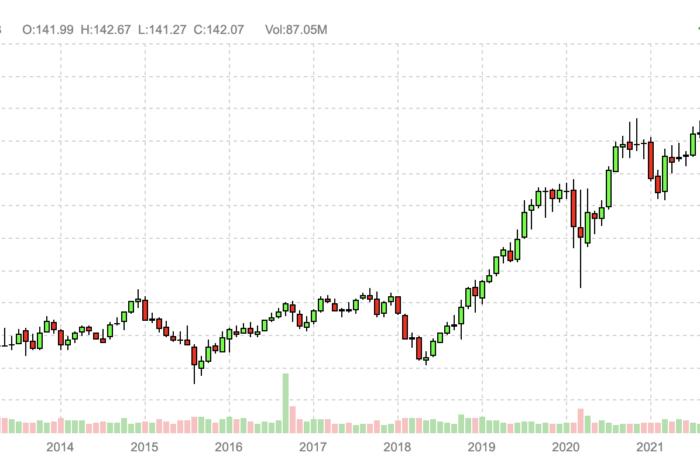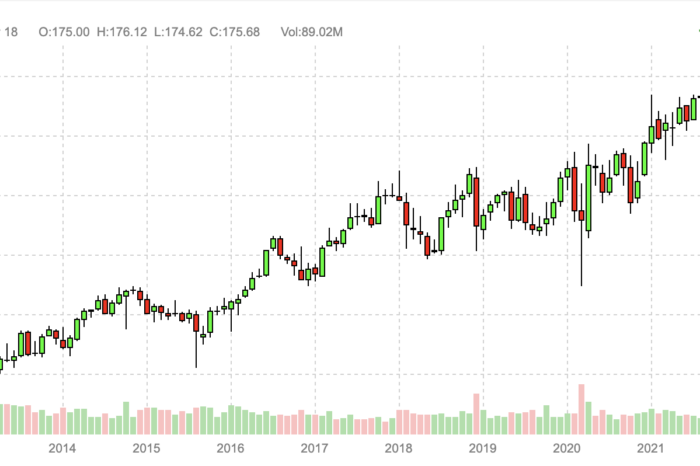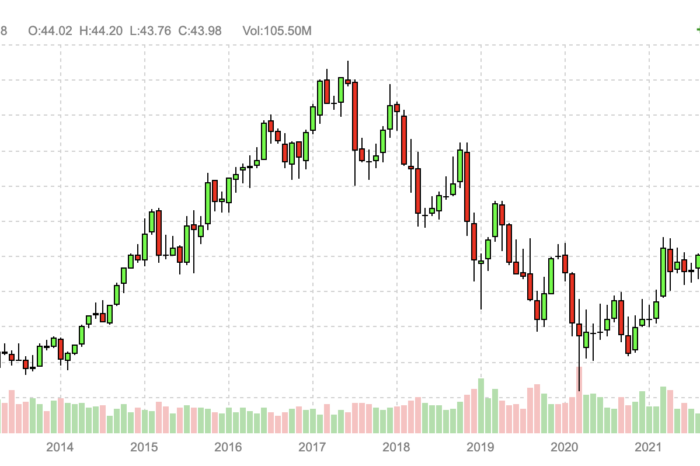This is a guest post by Jonathan Weber from Sure Dividend
The likelihood of a recession in the US and many other parts of the world has risen substantially in 2022. Rising interest rates will likely have a negative impact on economic growth, while supply chain disruptions due to COVID measures in China and the ongoing war in Ukraine also pose headwinds for the global economy. High inflation hurts the outlook for consumer spending, as consumers have less real disposable income due to spending more on necessities such as food and energy.
In this environment, investors may be especially interested in stocks that have a long track record of raising their dividends, even during recessions. For example, Dividend Aristocrats have increased their dividends for at least 25 consecutive years. Not too many stocks are able to do that, as more cyclical companies often see their profitability come under a lot of pressure during economic downturns, preventing them from maintaining their dividend growth track records.
However, there are companies that have proven to be resilient versus recessions, thanks to defensive business models, strong balance sheets, and competitive advantages. These proven stocks that have delivered consistent dividend growth for many years, no matter what, are especially interesting for conservative income investors. In this article, we will showcase three such stocks that grow their dividends in recessions.
1. Procter & Gamble (PG)
Procter & Gamble (PG) is a consumer staples company that belongs to the largest players in its industry. It sells its products in more than 180 countries in the world and owns a very wide range of brands. Its offerings include household and personal health items, cleaning products, and so on. Among its brands are well-established names such as Old Spice, Febreze, Oral-B, and many more.
Procter & Gamble has a history that dates back more than 130 years, and the company has increased its dividend every year for around half that time – it’s dividend growth track record spans 66 years, one of the longest such records of any publicly traded company anywhere. That makes Procter & Gamble a Dividend King, one of the most prestigious statuses income stocks can achieve.
Procter & Gamble is currently trading with a dividend yield of 2.6%, which is around one and a half times as much as what one can get from the broad market right now. Income investors thus get a very solid yield on top of ultra-reliable income growth.
Procter & Gamble’s business model is very resilient, as the products it sells are needed during economic downturns, too. While consumers may decide against buying a new vehicle, TV, etc., they will still buy household items that they need for their daily lives. Procter & Gamble has thus seen its profits remain resilient during past downturns. Combined with a very reasonable dividend payout ratio of 61%, that means that the dividend cut risk at Procter & Gamble is pretty low.
2. Johnson & Johnson (JNJ)
Johnson & Johnson (JNJ) is a diversified healthcare company that is active in pharmaceuticals, medical tech, and consumer staples. Pharmaceuticals make up the biggest unit, as they contribute roughly half of the company’s sales, with an above-average growth rate relative to the other two units. Medical tech/medical devices and consumer goods make up around 35% and 15% of sales, respectively.
Read also: The Top 3 High-Paying Dividend Stocks For 2023
Neither of the industries Johnson & Johnson is active in is cyclical, which explains why Johnson & Johnson has proven to be very resilient versus past crises, including economic downturns. Over the last decade, JNJ has been able to grow its earnings-per-share every year except for 2020. The company experienced an earnings-per-share decline of around 7% in that year, mainly due to the fact that the pandemic resulted in fewer surgeries, which was a headwind for the medical devices business.
And what about you? Do you have clearly defined investment goals? 🤔
We'll teach you how to do it 🎓🙏
➡ https://t.co/GO8D6x9dsH ⬅#stocks #shares #stocktrader #stockmarket #crypto #cryptocurrency #forex #commodity #analysis #trading #trader #market #investro pic.twitter.com/gB4UPWvjYW
— Investro.com (@investrocom) November 16, 2022
Johnson & Johnson hit a new record earnings-per-share level in 2021 and it looks like 2022 will be an even stronger year. Past crises have thus proven that Johnson & Johnson is resilient. That explains why the company was able to grow its dividend for an impressive 60 years in a row, making it a Dividend King. The payout ratio stands at just 45%, which, combined with the track record and JNJ’s resilience, makes for a very low dividend cut risk.
The dividend growth rate over the last decade averaged 7%, which is very solid. At current prices, Johnson & Johnson offers a dividend yield of 2.6%, which is attractive relative to what one can expect from the broad market. Combined with the solid dividend growth rate, Johnson & Johnson thus is an attractive dividend growth pick.
3. Altria (MO)
Altria (MO) is a tobacco company that is famous for its cigarette brand Marlboro, which it sells in the US. Outside of the US, the brand is controlled by Philip Morris (PM). Altria owns some non-tobacco businesses as well, such as a stake in beer company Anheuser-Busch InBev (BUD) and a wine business. Tobacco makes up the vast majority of its sales.
Read also: Weekly macro report – Too early to celebrate after CPI print
Tobacco sales are very resilient during all kinds of macro environments. During the pandemic year 2020, for example, Altria saw its sales grow, and its earnings-per-share hit a new record level. The company has been able to grow its earnings-per-share every year over the last decade, which makes the company a very reliable, low-risk, high-visibility business.
There’s no significant market growth in the tobacco space, but Altria and its peers have been successfully raising prices for many years, which allows them to grow their profits even without growing their sales volumes. Since that has worked for decades, there is little risk that this trend will suddenly stop. It can thus be expected that Altria will deliver some earnings growth in the future, too – for the current year, the company is forecasting an earnings-per-share increase of around 5%.
Altria offers a pretty high dividend yield of 8.5% at current prices. With a dividend yield this high, not a lot of dividend growth is needed to make Altria a worthwhile investment. Over the last decade, the dividend has grown by 8% a year. We believe that dividend growth will be less pronounced going forward, but even a dividend growth rate of just 2% would make total returns in the 10% range possible from here, thanks to a high starting dividend yield. With a 53-year dividend growth track record, there is little risk that Altria will stop increasing its dividend during future crises.













Comments
Post has no comment yet.